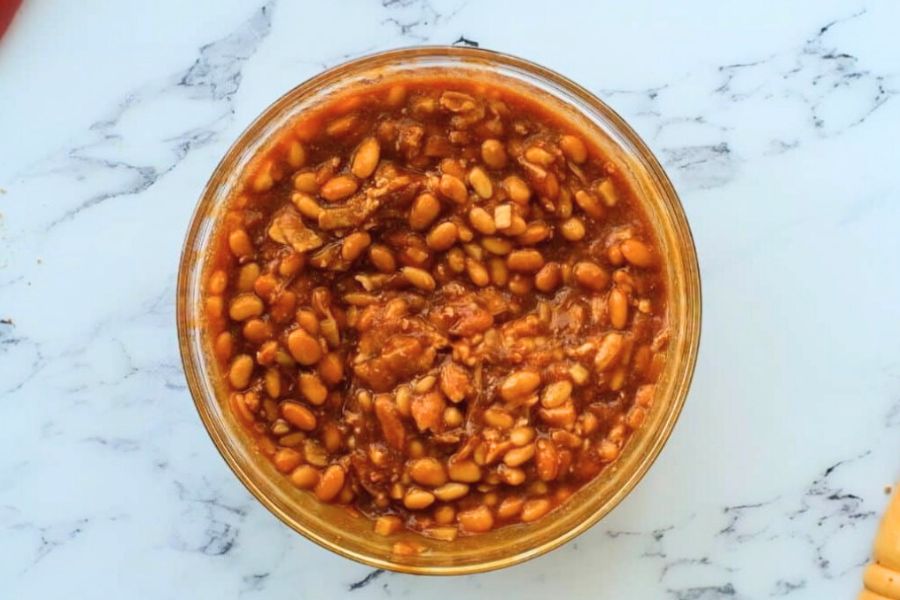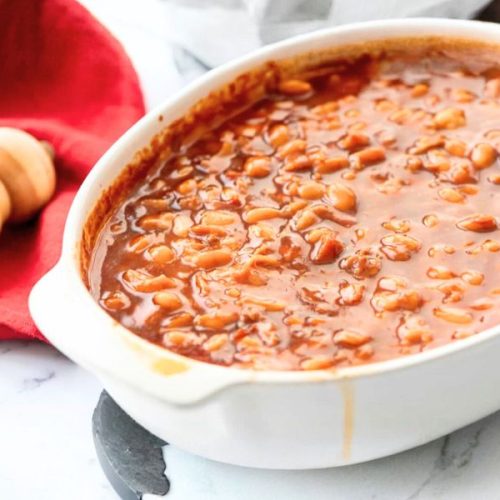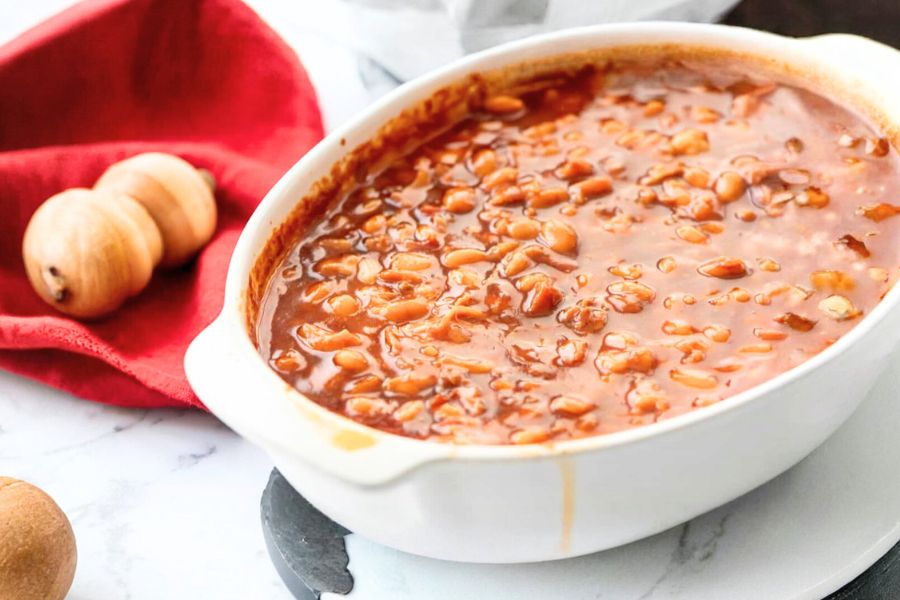This classic baked beans recipe shines with its perfect balance of sweet and savory flavors, thanks to the blend of maple syrup, molasses, and brown sugar combined with smoky bacon and tender navy beans.
Beyond its comforting taste, it’s a nutritional powerhouse: navy beans are an excellent source of plant-based protein and dietary fiber, promoting heart health and steady energy release.
This recipe also provides good fats from bacon while keeping saturated fats moderate, making it a hearty but balanced dish.
Ideal for everyday meals, it’s both satisfying and versatile—great as a side or main.

The long, slow baking develops rich depth without demanding constant attention, making it excellent for meal prep and batch cooking.
Must-Have Tools for Perfect Results
Large Skillet
Perfect for rendering bacon fat and sautéing onions, this pan ensures even cooking and flavor melding. Its versatility makes it indispensable for countless stovetop dishes beyond baked beans.
2-Quart Oven-Safe Baking Dish
Ideal for slow baking the beans to tender perfection while keeping moisture sealed. A sturdy baking dish is essential for casseroles, gratins, and roasted dishes alike.
Stockpot or Large Saucepan
Used for boiling and simmering soaked beans to achieve the ideal tender texture without falling apart. A good-quality stockpot is a must-have for soups, stews, and batch cooking.
Mixing Bowl
To combine sauces and ingredients smoothly before baking. A reliable mixing bowl supports prep work for a variety of recipes.
Measuring Cups and Spoons
Ensures accurate ingredient amounts for consistent results every time—critical for baking and balanced seasoning.

Easy and Flavorful Classic Baked Beans
Equipment
- 1 Large Skillet
- 1 2-Quart Oven-Safe Baking Dish
- 1 Large Stockpot or Saucepan
- 1 Mixing Bowl
- Measuring cups and spoons
Ingredients
- 1 ⅓ cups dried navy beans soaked overnight
- 3 slices thick-cut bacon chopped
- ¼ cup yellow onion minced
- ½ cup tomato sauce or ketchup
- ¼ cup molasses
- ¼ cup brown sugar adjust to taste
- ¼ cup pure maple syrup
- 1 teaspoon kosher salt
- 2 teaspoons dry mustard
- 1 tablespoon apple cider vinegar
- ½ cup apple juice or water
- ½ cup water plus extra if needed
Instructions
- Soak the Navy Beans: Begin by placing 1 ⅓ cups of dried navy beans in a large container with a lid. Pour enough cold water over the beans so that the water level is at least one inch above them. Seal the container and let the beans soak overnight, or for at least 8 to 12 hours. This soaking process softens the beans, reducing cooking time and improving their texture.
- Cook the Beans Until Tender: After soaking, drain the beans thoroughly and transfer them to a large stockpot. Cover the beans with fresh cold water, making sure the water rises about one inch above the beans. Bring the water to a rapid boil over high heat, then reduce to a gentle simmer. Let the beans cook uncovered for about 1 hour, or until they become tender but still hold their shape. Once cooked, drain the beans well and set aside.
- Prepare the Bacon and Onions: Preheat your oven to 300°F (150°C). Meanwhile, heat a large skillet over medium-high heat. Add the chopped bacon slices and cook until the fat begins to render and the bacon starts to brown. Add the minced yellow onion to the skillet and sauté together with the bacon for 5 to 6 minutes, stirring occasionally, until the onions are softened and the bacon is crisped to your liking. Drain off any excess bacon grease to avoid greasiness.
- Mix the Sauce and Combine Ingredients: In a large mixing bowl, whisk together the tomato sauce (or ketchup), molasses, brown sugar, pure maple syrup, kosher salt, dry mustard, apple cider vinegar, apple juice (or water), and an additional ½ cup of water. Once the sauce is well combined, add the cooked beans and the bacon-onion mixture. Gently fold all the ingredients together, ensuring the beans are evenly coated with the flavorful sauce.
- Bake the Beans Slowly: Transfer the bean mixture into a 2-quart oven-safe baking dish. The beans should be mostly submerged in liquid; if the mixture appears too dry, add up to ½ cup more water or apple juice to keep the beans moist during baking. Cover the dish tightly with aluminum foil or a fitted oven-safe lid. Bake the beans in the preheated oven for 2 hours to allow the flavors to meld and the beans to soften further.
- Finish Baking Uncovered for Thickness: After 2 hours, carefully remove the foil or lid from the baking dish. Return the beans to the oven and bake uncovered for an additional 30 to 40 minutes. This step helps the sauce thicken and develop a rich, glossy texture. The beans should be tender and the sauce slightly reduced but still saucy. Remove from oven and let cool slightly before serving.
Notes
- Bean Quality: Use fresh dried navy beans purchased within the last six months for best texture and flavor; older beans may take longer to cook and might remain tough.
- Substitutions: Pinto or great Northern beans can be swapped for navy beans if needed, but navy beans provide the classic texture and flavor.
- Using Canned Beans: If short on time, replace dried beans with two 15-ounce cans of rinsed and drained navy beans; adjust liquid accordingly.
- Vegetarian Option: Omit bacon and add raw minced onions directly to the sauce mixture. Increase salt by up to 1 teaspoon to compensate for bacon’s saltiness.
- Sweeter Beans: For a sweeter version, substitute tomato sauce with ketchup and increase brown sugar up to ½ cup.
- Storage & Freezing: Store leftovers in an airtight container in the fridge up to 5 days. Cool completely before freezing in freezer-safe containers for up to 3 months. Reheat in oven or microwave thoroughly before serving.
Chef’s Secrets for Ultimate Flavor
Achieving the perfect baked beans is all about layering flavors and managing textures.
Soaking the beans overnight softens them and reduces cooking time, while simmering them gently ensures they become tender without turning mushy.
Browning the bacon first releases flavorful fat that infuses the onions and ultimately the whole dish, adding smoky depth.
Using a combination of molasses, maple syrup, and brown sugar creates a complex sweetness that balances the tanginess from apple cider vinegar and tomato sauce.
For an extra touch of richness, make sure to drain excess bacon grease after sautéing to avoid greasiness.
Baking the beans covered allows moisture to circulate, making them tender, and finishing uncovered thickens the sauce into a luscious glaze.
Don’t rush the process—slow baking is key to developing those deep, comforting flavors.
Serving Suggestions to Elevate Meals
Homemade baked beans are incredibly versatile and pair beautifully with a range of dishes.
Serve them alongside grilled or smoked meats like BBQ ribs, pulled pork, or chicken for a classic picnic or cookout combo.
They also make a hearty side for vegetarian meals, complementing roasted vegetables, baked potatoes, or grain bowls.
For a filling main, try spooning baked beans over warm toast or cornbread for a comforting breakfast or brunch.
Adding a sprinkle of fresh herbs such as parsley or chives just before serving adds a pop of color and freshness.
If you like a little heat, a dash of hot sauce or chopped jalapeños can kick up the flavor. These beans are equally delicious cold or reheated, making them perfect for packed lunches or meal prep.
Storage Tips to Keep Beans Fresh
Proper storage is essential to maintain the flavor and texture of your baked beans. After cooking, allow the beans to cool completely before transferring them to an airtight container.
Stored in the refrigerator, they will keep well for up to five days, making them a great make-ahead side or quick meal component.
For longer storage, place cooled beans in freezer-safe containers or bags, leaving a little headspace for expansion. Frozen baked beans can last up to three months without losing quality.
When reheating, thaw beans overnight in the fridge for best results, then warm them gently in the oven covered with foil to retain moisture.
Microwaving is convenient but stir frequently to heat evenly and prevent drying out.
Frequently Asked Questions Answered Clearly
1. Can I use canned beans instead of dried?
Yes, canned navy beans can be used to save time. Rinse and drain two 15-ounce cans and adjust the liquid in the recipe accordingly to prevent the dish from becoming too watery.
2. What’s the best type of bean for baked beans?
Traditional baked beans call for navy beans because of their creamy texture and ability to hold their shape. Pinto or great Northern beans can be good substitutes if needed.
3. Can I make this recipe vegetarian?
Absolutely! Simply omit the bacon and add raw onions directly to the sauce mixture. Increase salt slightly to compensate for the lost bacon flavor.
4. How sweet should the beans be?
Sweetness is adjustable to taste. Start with the suggested ¼ cup brown sugar and maple syrup, then add more if you prefer a sweeter profile. Using ketchup instead of tomato sauce also increases sweetness.
5. How do I prevent the beans from drying out during baking?
Covering the baking dish during most of the cooking keeps moisture locked in. If the beans look dry midway, add a splash of water or apple juice. Remove the cover only toward the end to thicken the sauce.
This recipe has been adapted and simplified from the original version by amindfullmom. We’ve refined the steps for a smoother cooking experience and added helpful notes, nutrition insights, and essential kitchen tools to make it even easier for home cooks.

